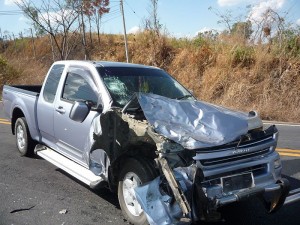
To those in the oil and gas industry, it’s a well known fact that truck driving is one of the most dangerous parts of the job. However, this may come off as absolutely shocking to many of those who don’t work in the industry. Many would assume that the oil rig itself is where most of the problems lie. They understand that the life of a roughneck isn’t easy and may even grimace at the fact of having to work longer than 8 hours a day, let alone 16! But the biggest cause of oil field fatalities isn’t from roughnecks making careless mistakes at their job sites by improperly using heavy machinery. While these situations DO happen, the biggest cause of death actually occurs off site when drivers are transporting their vehicles from one location to the next.
Between 2003 and 2008 there were fatalities of around 650 oil field workers, a number that is already well above most other industries. Around 33% of those deaths were attributed to oil field trucking accidents! This makes oil field trucking by and by the largest threat to anyone who is working in the field.

So what is it about driving that makes it so lethal? Common sense would indicate that workers are much safer once they get away from all the potential hazards they encounter on the job site. This logic, however, neglects the crucial ingredient to the oil field trucker poison: Fatigue. 56% of the accidents only involve one-vehicle swerving off the road and killing either the driver or the passenger. This is usually the result of the truck driver falling asleep at the wheel and steering the truck to immediate peril. Furthermore, many of the accidents involve pick up trucks, indicating that it may not be just the cause of operating the advanced machinery.
The next sensible question becomes, “Why is it specifically oil truckers who are susceptible to these fatal accidents? Truck drivers in other industries don’t seem to have this problem”. A New York times article found the answer to this. The problem here lies in differing expectations and regulations for each industry. The article revealed that oil workers are under an immense pressure to work 20 hours shifts due to scheduling and pay incentives. Truckers in the other industries are required to take restart breaks of 34 hours after working 70 hours over consecutive days. However, an HOS “oilfield exemption” is in place so that oilfield truckers can work longer hours and thus move more water that was required for hydrofracking . This exemption allows them to only take 24 hour breaks for the same amount of working hours. Even though the exemption has been brought to the FMCSA’s attention, they have decided to stand by their decision to uphold this exemption.
Signs Of A Tired Oilfield Truck Driver
While we support the right of every trucker to get their proper amount of driving hours logged, we also want them and others to be aware of signs that might indicate that it’s best to stop the truck and rest for a little.
- The driver has trouble completely 100% focusing on the road
- The truck driver cannot drive the vehicle completely straight. The vehicle begins to swerve within the lane
- The driver’s reaction time is significantly impacted. Finds themselves braking and turning later than they normally do
- The driver can’t keep their eyes open
Remember, be careful when you’re driving after extended periods of work with very little sleep in between for your own safety and for the safety of others around you. You’ll be thankful for it in the long run.